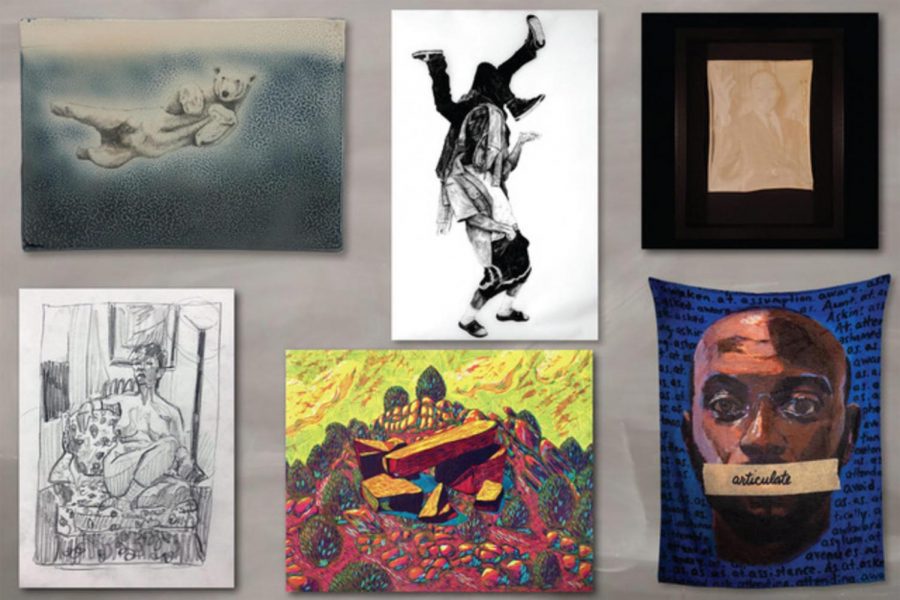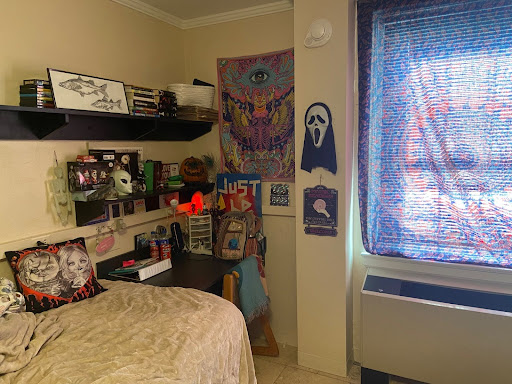Art department faculty showcase recent works in Guilford’s Art Gallery
From top left to bottom right are pieces by Guilford Art faculty Charlie Tefft, Antoine Williams, Alyssa Miserendino, William Paul Thomas, Katy Collier and Miranda Reichhardt.
As spring semester began on Monday, Jan. 13, the Guilford College Art Gallery launched the fifteenth biennial Art Faculty Exhibition. Under the warm, bright lights of the gallery lie dozens of pieces created by nine of the College’s professors.
Art Gallery Curator Theresa Hammond discussed the gallery in a press release.
“(The exhibition) highlight(s) the diversity of ideas, materials and imagery these artists explore,” Hammond said. “(It) includes collage, drawing, painting, photography, printmaking, a mixed-media sound installation, set and costume design and ceramics. Faculty exhibitors include: Roxanne Campbell (photography), Katy Collier (printmaking), Mark Dixon ’96 (mixed media sound installation), Alyssa Miserendino (photography), Miranda Reichhardt (drawing), Charles Tefft ’97 (ceramics), William Paul Thomas (painting), Robin Vest (set & costume design) and Antoine Williams (mixed media & collage)”.
The entries, such as the enormous fleece blanket of Thomas’ “The Curious Case of the Articulate Academic,” a portrait of fellow colleague Antoine Williams, as well as the large, expansive canvas of Reichhardt’s “Waiting for Good D,” are varying in size. The exhibition also featured smaller pieces, such as the detailed sets of Robin Vest’s “From the Page to the Stage: Scenic Design Process for Peter Pan at Children’s Theatre of Charlotte” series.
While pieces differ in the choice of color, some share similar themes of using color symbolically. Williams’ views on intersectionality can be seen through the black and white drawing, “Study of a Hotep on to the Myth of Power.”
“This piece specifically looks at Hotepism—a toxic Black masculinity that upholds anti-Blackness,” Williams wrote in his artist statement. “Hoteps don’t want to dismantle white supremacy; they want to replace it.”
Meanwhile, the usage of a high-saturated purple, implying faith in Jamaica, is displayed in Campbell’s photography series, “The Color Purple.”
“It reframes spiritual practices, which are often seen as barbaric once they veer from western practices where they are seen as actually quite human,” stated Campbell on her images.
What seems to be the most striking about the diversity of pieces in the exhibition is how one interprets the art, which can be seen in the front of the gallery.
To the left of the entrance stands a towering assortment of gutter downspouts, an exercise bike and a fifty-five-gallon drum. Water drips down the spouts, making it sound as if the art gallery is actually leaking.
Mark Dixon’s “Homage to Civ” is, in fact, palpable as well as an interactive piece.
“Technically, a handful of drips dripping together is chaotic, never repeating and unpredictable. It ought to sound like a total mess, but I can always make it into music in my mind,” Dixon wrote.
Dixon’s directions of “Homage to Civ” states, “If you want to activate Homage to Civ, ride the bike gently and briefly. Please do not peddle if water is already dripping.”
To the right, eight prints of historical figures hang on the wall. Some are widely revered, such as Abraham Lincoln and Dr. Martin Luther King, Jr. Others are widely disgraced, such as Adolf Hitler and Pol Pot.
The “Snake Skin” series by Alyssa Miserendino is inspired by a quote by Patrick Harpur, provides food for thought for its audience and keeps them guessing what these figures have in common. Miserendino, however, provides the connection:
“These images represent a sampling of political leaders who suffer or suffered from mental illness,” Miserendino said. “Not all these leaders have been officially diagnosed. For those unofficially diagnosed, the conclusion is based on documented behaviors.”
The exhibition includes art that is for sale, such as ceramics professor Charlie Tefft’s ceramic jars and printmaking professor Katy Collier’s woodcuts.
A reception featuring the artists for the exhibition will be held Wednesday, Jan. 29, 5-7 p.m. in Hege Library’s Art Gallery. Admission is free for the public in the gallery and the reception. The fifteenth biennial Art Faculty Exhibition will be on display until March 4. For more information, curator Theresa Hammond can be contacted at 336-316-2438 or [email protected].
Editor’s note: This story originally was published in Volume 106, Issue 9 of The Guilfordian on Jan. 24, 2020.






